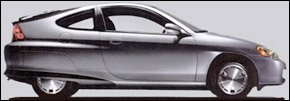
Like every other Insight owner, I'm really worried about parking lots where uncaring drivers open their doors into the side of your car. The Insight is more vulnerable than any other car because its aluminum body is so much easier to dent than a steel one.
Honda's designers could have reduced this danger by using plastic in place of aluminum to cover the doors, but the aluminum skin is an integral part of the monocoque door, providing essential strength for crash protection. A car like the Saturn can use plastic door skins only because the structure underneath is so hefty that it doesn't need the skin to contribute any strength. This construction method doesn't lend itself to the kind of lightweight car that gets 70 mpg, so the Insight has aluminum door skins.
I speculate that the designers of the Insight did not include a side molding for a these reasons:
To be effective, a side molding must be positioned to intercept the doors of the uncaring drivers' cars it will encounter. To look good, the addition of a side molding should not alter a car's basic lines. These two goals come into conflict when considering the addition of a side molding to the Insight.

This is a scan of the photo from the Insight magazine advertisement. I hope that someday I can tell the photographer personally how perfect the lighting is in this photo. Every nuance of the design is highlighted.
As can be seen in this photo, the side of the Insight's body has three basic horizontal lines. The top line extends the entire length of the body, dividing the door handle. The next horizontal line--very close to the top one--incorporates the top of the front wheel arch and the top edge of the rear "hip." Unlike the top line, however, this line fades out in the center of the car. There is also a third horizontal line much lower on the body, but it is a concave, rather than a convex feature so it is not a candidate for the location of a body-protecting molding.
The top line is too high to protect the Insight's body from the doors of other cars. Therefore, the second, incomplete horizontal line is the logical place to add a door molding as shown in red in the following photo.

As you can see, adding a side molding here is a tricky visual proposition. If the molding is to protect the entire length of the car, it must be attached above the wheel well in the front, and below the top edge of the "hip" in the rear. Depending on the exact position of the molding, it either connects the disconnected line or, in effect, creates yet another horizontal line where the body is the widest, thus defeating the brilliant Insight designer's intentions. (Who is that person, anyway? We get to know who designed the New Beetle, why not the beautiful body of the Insight?)
Finally, there's the question of whether a stick-on plastic molding would actually prevent a door impact from denting the Insight's aluminum skin. Even if there's a structural member directly behind the molding, it would have to be extraordinarily strong (and heavy) to withstand an assault by a heavy steel door flung open by a jerk.
In my opinion, once Honda decided to build a 70 mile-per-gallon aluminum car, they realized there was no way to build in protection from the inconsiderate owners of other cars. They left it up to us, the owners, to protect our cars as best as we can. So park your Insight wisely and think of the long walks as good exercise.